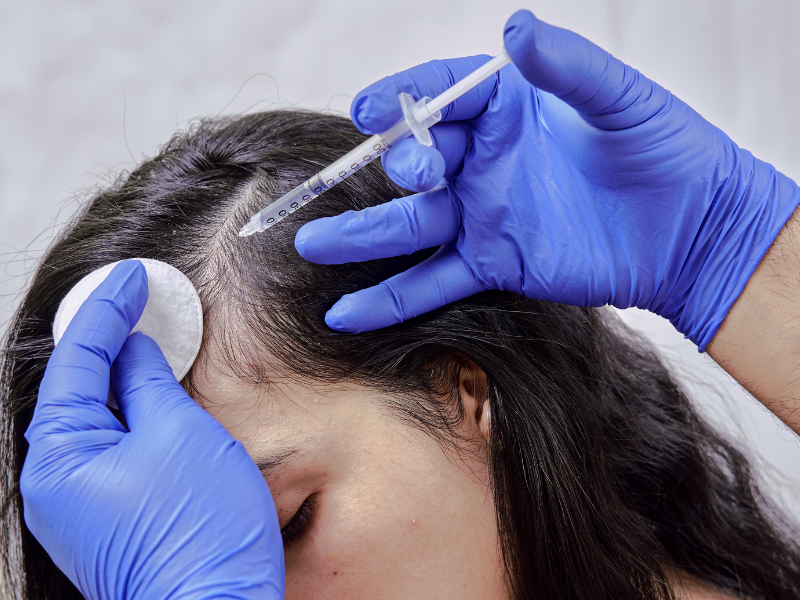When it comes to skincare trends, most of them disappear as quickly as they arrive. But every now and then, something comes along that people actually keep booking again and again.
Mesotherapy is one of those treatments.
If you’ve heard the name floating around and wondered what is mesotherapy, here’s a straight-talking guide to what it does, who it’s for, and why it’s suddenly all over your social feed.
So, What Is Mesotherapy?
Mesotherapy is a non-surgical cosmetic treatment where a cocktail of vitamins, minerals, amino acids and other active ingredients is injected just beneath the skin’s surface.
It was first developed in France in the 1950s to treat medical conditions like joint pain and poor circulation. However, today, it’s best known for its effects on the face, neck, scalp, and body in the beauty world.
It uses very fine needles to deliver small doses of product into the mesoderm – that’s the middle layer of your skin. The goal? To nourish, hydrate, tighten, and even out your skin from the inside out.
What Does It Help With?
Mesotherapy isn’t just one thing. It can be tailored to different goals, which is why so many people are curious about it.
Here’s what it’s commonly used for:
- Skin rejuvenation – adding glow, hydration and firmness
- Fine lines and wrinkles – particularly around the eyes and mouth
- Pigmentation and dullness – to even out skin tone
- Hair thinning – stimulating the scalp to encourage growth
- Cellulite and stubborn fat – breaking down fatty deposits and improving circulation
Some clinics also offer mesotherapy for treating stretch marks and acne scars, although results vary depending on the skin type and severity of the condition.
What’s In the Injections?
That depends on your needs. Your practitioner can create a custom mix, but common ingredients include:
- Hyaluronic acid – to hydrate and plump
- Vitamins C, A, E, B-complex – for repair and radiance
- Amino acids – to support collagen production
- Coenzymes and antioxidants – to fight off environmental damage
- Plant extracts and peptides – for firming and tightening
Clinics may also add small amounts of pharmaceutical agents for specific concerns, like caffeine for cellulite or minoxidil for hair growth.
How Long Does It Take?
The treatment itself usually takes 30 to 45 minutes, depending on the area. You might need a course of 4 to 6 sessions, spaced about two weeks apart, to see full results.
After that, maintenance sessions every few months help keep the glow going.
Does It Hurt?
It’s not exactly a spa facial, but it’s usually well-tolerated.
Some people describe it as a series of small pinches or pricks. Numbing cream can be used beforehand to reduce discomfort, especially in more sensitive areas like under the eyes.
You might have mild redness or swelling straight after, but this tends to fade within 24–48 hours.
What’s the Aftercare?
After mesotherapy, you should:
- Avoid touching your face for several hours
- Skip makeup for 24 hours
- Stay out of the sun for a few days
- Avoid intense workouts, saunas and alcohol for at least 48 hours
These steps help your skin heal and absorb the ingredients fully.
How Much Does It Cost?
Prices vary depending on the clinic and the area being treated, but expect:
- Face or neck – from £150 to £300 per session
- Scalp (for hair loss) – similar pricing
- Body (cellulite/fat areas) – from £200 per area per session
Packages can sometimes bring the cost down, especially if you’re committing to multiple sessions upfront.
Is It Safe?
When performed by a trained and qualified practitioner, mesotherapy is considered safe.
However, because it involves injections, there are some risks, including:
- Bruising
- Swelling
- Itching or tenderness
- Allergic reaction (rare)
Always choose a reputable clinic. Ask questions, check qualifications, and avoid anyone offering suspiciously cheap deals.
Worth a Closer Look
So, what is mesotherapy?
It’s a fast-growing skin treatment that delivers nutrients directly into the skin where they’re needed most. Whether you’re chasing glow, hydration, firmer skin or fuller hair, this could be worth a closer look.
It’s often not an overnight miracle. But when done well – and done consistently – it might just become the secret weapon in your skincare routine.

